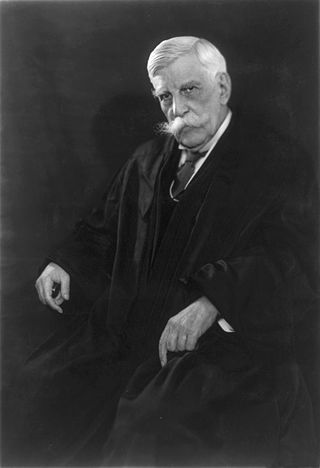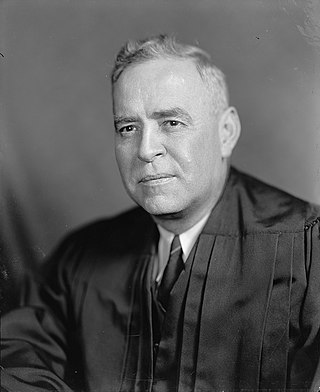
Clear and present danger was a doctrine adopted by the Supreme Court of the United States to determine under what circumstances limits can be placed on First Amendment freedoms of speech, press, or assembly. The test was replaced in 1969 with Brandenburg v. Ohio's "imminent lawless action" test.

Hugo Lafayette Black was an American lawyer, politician, and jurist who served as a U.S. Senator from Alabama from 1927 to 1937 and as an associate justice of the U.S. Supreme Court from 1937 to 1971. A member of the Democratic Party and a devoted New Dealer, Black endorsed Franklin D. Roosevelt in both the 1932 and 1936 presidential elections. Before he became a Senator, Black espoused anti-Catholic views and was a member of the Ku Klux Klan in Alabama. An article from the Pittsburgh Post-Gazette reports that he temporarily resigned from the Klan in 1925 to bolster his senatorial campaign, before quietly rejoining the Klan in 1926. In 1937, upon being appointed to the Supreme Court, Black said: "Before becoming a Senator I dropped the Klan. I have had nothing to do with it since that time. I abandoned it. I completely discontinued any association with the organization." Black served as the Secretary of the Senate Democratic Conference and the Chair of the Senate Education Committee during his decade in the Senate. Having gained a reputation in the Senate as a reformer, Black was nominated to the Supreme Court by President Roosevelt and confirmed by the Senate by a vote of 63 to 16. He was the first of nine Roosevelt appointees to the court, and he outlasted all except for William O. Douglas.
Schenck v. United States, 249 U.S. 47 (1919), was a landmark decision of the U.S. Supreme Court concerning enforcement of the Espionage Act of 1917 during World War I. A unanimous Supreme Court, in an opinion by Justice Oliver Wendell Holmes Jr., concluded that Charles Schenck, who distributed flyers to draft-age men urging resistance to induction, could be convicted of an attempt to obstruct the draft, a criminal offense. The First Amendment did not protect Schenck from prosecution, even though, "in many places and in ordinary times, Schenck, in saying all that was said in the circular, would have been within his constitutional rights. But the character of every act depends upon the circumstances in which it is done." In this case, Holmes said, "the words used are used in such circumstances and are of such a nature as to create a clear and present danger that they will bring about the substantive evils that Congress has a right to prevent." Therefore, Schenck could be punished.
Dennis v. United States, 341 U.S. 494 (1951), was a United States Supreme Court case relating to Eugene Dennis, General Secretary of the Communist Party USA. The Court ruled that Dennis did not have the right under the First Amendment to the United States Constitution to exercise free speech, publication and assembly, if the exercise involved the creation of a plot to overthrow the government. In 1969, Dennis was de facto overruled by Brandenburg v. Ohio.
R.A.V. v. City of St. Paul, 505 U.S. 377 (1992), is a case of the United States Supreme Court that unanimously struck down St. Paul's Bias-Motivated Crime Ordinance and reversed the conviction of a teenager, referred to in court documents only as R.A.V., for burning a cross on the lawn of an African-American family since the ordinance was held to violate the First Amendment's protection of freedom of speech.
Brandenburg v. Ohio, 395 U.S. 444 (1969), is a landmark decision of the United States Supreme Court interpreting the First Amendment to the U.S. Constitution. The Court held that the government cannot punish inflammatory speech unless that speech is "directed to inciting or producing imminent lawless action and is likely to incite or produce such action". Specifically, the Court struck down Ohio's criminal syndicalism statute, because that statute broadly prohibited the mere advocacy of violence. In the process, Whitney v. California (1927) was explicitly overruled, and Schenck v. United States (1919), Abrams v. United States (1919), Gitlow v. New York (1925), and Dennis v. United States (1951) were overturned.
Whitney v. California, 274 U.S. 357 (1927), was a United States Supreme Court decision upholding the conviction of an individual who had engaged in speech that raised a threat to society. Whitney was explicitly overruled by Brandenburg v. Ohio in 1969.

Wiley Blount Rutledge Jr. was an American jurist who served as an associate justice of the Supreme Court of the United States from 1943 to 1949. The ninth and final justice appointed by President Franklin D. Roosevelt, he is best known for his impassioned defenses of civil liberties. Rutledge favored broad interpretations of the First Amendment, the Due Process Clause, and the Equal Protection Clause, and he argued that the Bill of Rights applied in its totality to the states. He participated in several noteworthy cases involving the intersection of individual freedoms and the government's wartime powers. Rutledge served on the Court until his death at the age of fifty-five. Legal scholars have generally thought highly of the justice, although the brevity of his tenure has minimized his impact on history.
Abrams v. United States, 250 U.S. 616 (1919), was a decision by the Supreme Court of the United States upholding the 1918 Amendment to the Espionage Act of 1917 which made it a criminal offense to urge the curtailment of production of the materials necessary to wage the war against Germany with intent to hinder the progress of the war. The 1918 Amendment is commonly referred to as if it were a separate Act, the Sedition Act of 1918.
Chaplinsky v. New Hampshire, 315 U.S. 568 (1942), was a landmark decision of the US Supreme Court in which the Court articulated the fighting words doctrine, a limitation of the First Amendment's guarantee of freedom of speech.
"Imminent lawless action" is one of several legal standards American courts use to determine whether certain speech is protected under the First Amendment of the United States Constitution. The standard was first established in 1969 in the United States Supreme Court case Brandenburg v. Ohio.
"The Constitution is not a suicide pact" is a phrase in American political and legal discourse. The phrase expresses the belief that constitutional restrictions on governmental power must be balanced against the need for survival of the state and its people. It is most often attributed to Abraham Lincoln, as a response to charges that he was violating the United States Constitution by suspending habeas corpus during the American Civil War. Although the phrase echoes statements made by Lincoln, and although versions of the sentiment have been advanced at various times in American history, the precise phrase "suicide pact" was first used in this context by Justice Robert H. Jackson in his dissenting opinion in Terminiello v. Chicago, a 1949 free speech case decided by the U.S. Supreme Court. The phrase also appears in the same context in Kennedy v. Mendoza-Martinez, a 1963 U.S. Supreme Court decision written by Justice Arthur Goldberg.

Masses Publishing Co. v. Patten, 244 F. 535, was a decision by the United States District Court for the Southern District of New York, that addressed advocacy of illegal activity under the First Amendment.
Feiner v. New York, 340 U.S. 315 (1951), was a United States Supreme Court case involving Irving Feiner's arrest for a violation of section 722 of the New York Penal Code, "inciting a breach of the peace," as he addressed a crowd on a street.
Kunz v. New York, 340 U.S. 290 (1951), was a United States Supreme Court case finding a requirement mandating a permit to speak on religious issues in public was unconstitutional. It was argued October 17, 1950, and decided January 15, 1951, 8–1. Chief Justice Vinson delivered the opinion for the Court. Justice Black and Justice Frankfurter concurred in the result only. Justice Jackson dissented.
American Communications Association v. Douds, 339 U.S. 382 (1950), is a 5-to-1 ruling by the United States Supreme Court which held that the Taft–Hartley Act's imposition of an anti-communist oath on labor union leaders does not violate the First Amendment to the United States Constitution, is not an ex post facto law or bill of attainder in violation of Article One, Section 10 of the United States Constitution, and is not a "test oath" in violation of Article Six of the Constitution.

The Vinson Court refers to the Supreme Court of the United States from 1946 to 1953, when Fred M. Vinson served as Chief Justice of the United States. Vinson succeeded Harlan F. Stone as Chief Justice after the latter's death, and Vinson served as Chief Justice until his death, at which point Earl Warren was nominated and confirmed to succeed Vinson.
Times Film Corporation v. City of Chicago, or Times v. City of Chicago is the name of two cases decided by the U.S. Supreme Court in 1957 and 1961. Both involved the issue of limits on freedom of expression in connection with motion pictures. In both cases the court affirmed the right of local governments to engage in some form of censorship.
Hess v. Indiana, 414 U.S. 105 (1973), was a United States Supreme Court case involving the First Amendment that reaffirmed and clarified the imminent lawless action test first articulated in Brandenburg v. Ohio (1969). Hess is still cited by courts to protect speech threatening future lawless action.
Hate speech in the United States cannot be directly regulated by the government due to the fundamental right to freedom of speech protected by the Constitution. While "hate speech" is not a legal term in the United States, the U.S. Supreme Court has repeatedly ruled that most of what would qualify as hate speech in other western countries is legally protected speech under the First Amendment. In a Supreme Court case on the issue, Matal v. Tam (2017), the justices unanimously reaffirmed that there is effectively no "hate speech" exception to the free speech rights protected by the First Amendment and that the U.S. government may not discriminate against speech on the basis of the speaker's viewpoint.





